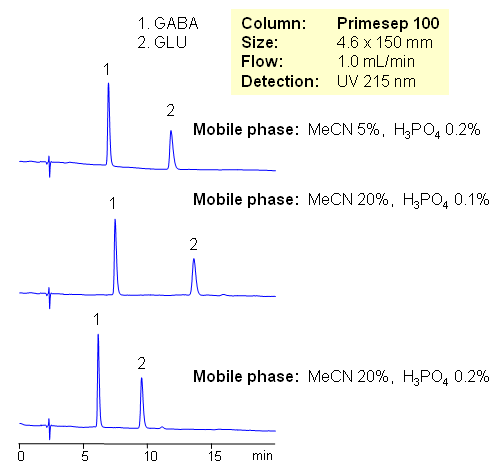
Amino acids are building blocks for peptides and proteins; they are used in various supplement formulations and as starting reagents in chemistry to introduce chirality. GABA and GLU are used to enhance growth of specified plants, prevent development of powdery mildew on grapes, and suppress certain other plant diseases. L-Glutamic acid is one of the major amino acids naturally found in plant and animal proteins, and GABA helps to maintain normal brain function. Both amino acids behave as neurotransmitters. All amino acids have both basic and acidic groups. Depending on pH amino acids can be basic, acidic or zwitter-ionic. Due to the polar nature of underivatized amino acids, analysis is a very challenging task. Derivatization and ion-pairing reagents are used to provide retention of amino acids. Simple method is developed on Primesep 100 column using combination of acetonitrile/water with phosphoric acid as a mobile phase. Method uses UV detection. Amino acids are well retained without use of ion-pairing reagents. Fast reliable method can be developed for all underivatized natural and synthetic amino acids.
| Column | Primesep 100, 4.6×150 mm, 5 µm, 100A |
| Mobile Phase | MeCN/H2O |
| Buffer | H3PO4 |
| Flow Rate | 1.0 ml/min |
| Detection | UV, 215 nm |
| Class of Compounds |
Drug, Acid, Hydrophilic, Ionizable, Vitamin, Supplements, Amino acid |
| Analyzing Compounds | GABA, Glu |
Application Column
Primesep 100
The Primesep family of mixed-mode columns offers a wide variety of stationary phases, boasting unprecedented selectivity in the separation of a broad array of chemical compounds across multiple applications. Corresponding Primesep guard columns, available with all stationary phases, do not require holders. SIELC provides a method development service available to all customers. Inquire about our specially-tailored custom LC-phases for specific separations.
Select optionsgamma-Aminobutyric Acid (GABA)





